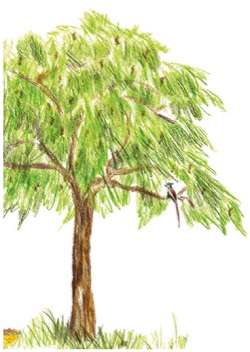
Tamarind
The tamarind tree grows to a height of over 20 metres. It has a long straight trunk with dark brown bark. The branches are strong and supple and droop downwards. The tiny leaves are of a fresh green colour and form graceful, feathery foliage. They are also sour like the tamarind and are nice to eat.
The tamarind has beautiful yellow flowers with thin streaks of red. When the flower dries up, its place is taken by a tamarind pod. The pod is green and gradually turns a light brown as it ripens. It is like suede to touch.
When it ripens in winter, it becomes a deep brown and the pulp inside is sour with a hint of sweetness. Tamarind seeds are dark brown and enclosed inside the pulp. Squirrels and birds love to eat ripe tamarind. Children also love raw tamarind dipped in rock salt, though it can give them a sore throat sometimes.
Tamarind is used to make delicious curries, pickles, chutneys and tangy jal jeera, which is not only cooling in Summer, but also delicious with gol gappas.
Tamarind is very rich in iron and vitamin C. The seeds are dried and powdered and can be used as a flour. Tender tamarind leaves and tamarind flowers are also used in cooking.
The tree gives very dense shade in summer. There are many superstitions in India about the tamarind tree. People believe that ghosts live on its branches and that one must not sleep under it at night.
If you look closely at the leaves of a tamarind tree at night, you will notice that they fold up. Of course, the truth is that, because the big tree breathes out carbon dioxide, it is not healthy to sleep under it at night. It is thought that many, many years ago, the tree was brought from Africa. It began to grow very well in this country and now it is very hard to believe that it came from another country.


